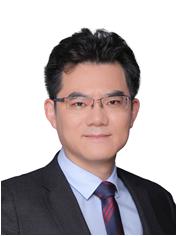About the speaker
Ke Guan (Senior Member, IEEE) received B.E. degree and Ph.D. degree from Beijing Jiaotong University in 2006 and 2014, respectively. He is a Full Professor in State Key Laboratory of Rail Traffic Control and Safety & School of Electronic and Information Engineering, Beijing Jiaotong University. In 2016, he has been awarded a Humboldt Research Fellowship for Postdoctoral Researchers. He was a Visiting Scholar with Universidad Politécnica de Madrid, Spain in 2009 and 2013. From 2011 to 2013 and from 2016 to 2018, he was a Research Scholar with the Institut für Nachrichtentechnik (IfN) at Technische Universität Braunschweig, Germany. From February 2023 to July 2023, he was a Guest Professor at Technische Universität Wien, Austria. He has authored/coauthored two books and five book chapter, more than 200 journal and conference papers, and ten patents. His current research interests include measurement and modelling of wireless propagation channels, high-speed railway communications, ray-tracing and machine learning based digital twin of electromagnetic environments in various complex scenarios, such as vehicle-to-x communications, terahertz communication systems, integrated sensing and communications, and space-air-ground integrated networks.
Dr. Guan is the pole leader of EURNEX (European Railway Research Network of Excellence). He was the recipient of a 2014 International Union of Radio Science (URSI) Young Scientist Award. His papers received 14 Best Paper Awards, including IEEE vehicular technology society Neal Shepherd memorial best propagation paper award in 2019 and 2022. He is an Editor of IEEE Vehicular Technology Magazine and IET Microwave, Antenna and Propagation, and a Guest Editor of the IEEE Transactions on Vehicular Technology and IEEE Communication Magazine. He serves as a Publicity Chair in PIMRC 2016, the Publicity Co-Chair in ITST 2018, the Track Co-Chair in EuCNC, the International Liaison of EUSIPCO 2019, the Session Convener of EuCAP 2015-2022, and a TPC Member for many IEEE conferences, such as Globecom, ICC and VTC. He has been a delegate in 3GPP and a member of the IC1004, CA15104, and CA20120 initiatives.
Abstract
6G and beyond will fulfill the requirements of a fully connected world and provide a high data rate and dependable wireless connectivity for all intelligent devices and services, in terms of communications, sensing, and localization. One of the high-value 6G applications is autonomous driving, which requires the integration of multispectral sensing (such as millimeter wave radar, LIDAR, camera), multispectral wireless communication, edge computing and so on, to achieve comprehensive sensing, ubiquitous interconnection and intelligent decision-making. In response to these requirements, highly accurate channel data need to be realized in various scenarios at all frequency bands from sub-6 GHz to millimeter-wave (mmWave), terahertz (THz), and visible light communication (VLC) bands. This speech presents the recent progress on multispectral ray-tracing (RT) plus artificial intelligence (AI) for high-fidelity channel modeling.
To begin with, electromagnetic (EM) property and propagation mechanism libraries need to be built for various materials at different bands, either from propagation mechanism measurements for a single material or channel sounding measurements in the target scenario. Then, through extensive simulations using a high-performance RT platform, realistic channel data can be obtained not only for communication channels in challenging conditions (such as mmWave channels with a high-speed train at the speed of 500 km/h) but also for multi-band sensing signals (such as mmWave radar, Light Detection And Ranging, and camera). Moreover, machine learning models for super-resolution of wireless channel characteristics are presented to show how AI can be beneficial for increasing the efficiency of generating channel data while keeping high fidelity. Last but not the least, in order to enhance the potential of RT, we identify the challenges and contemplate the future research outlook toward breaking through these bottlenecks from the perspectives of the input data, algorithms, and computing power.
